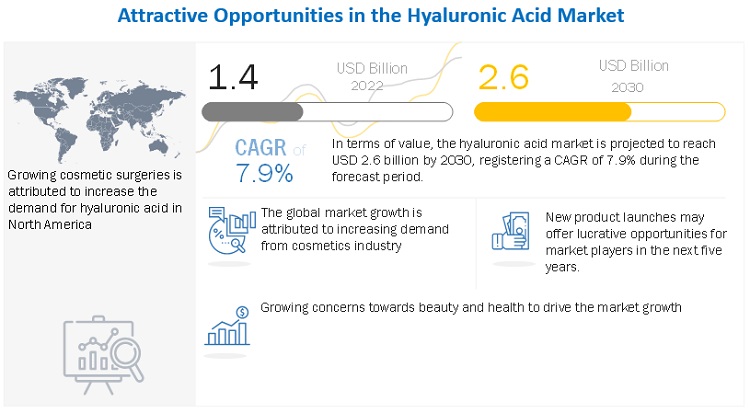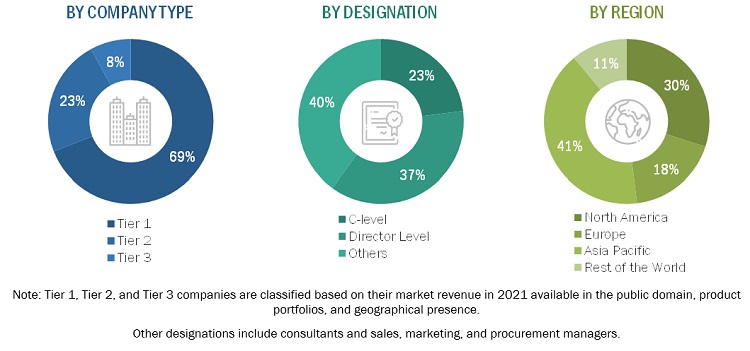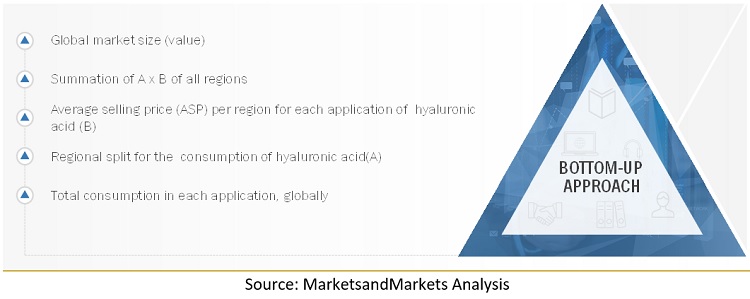Hyaluronic Acid Market by Application (Osteoarthiritis, Cosmetics, Pharmaceutical API, Ophthalmology), End-Use Industry (Personal Care Industry, Pharmaceutical Industry, Others) and Region (North America, Europe, Asia Pacific, South America, Middle East & Africa - Global Forecast to 2030
Updated on : July 15, 2024
Hyaluronic Acid Market
The global hyaluronic acid market was valued at USD 1.4 billion in 2022 and is projected to reach USD 2.6 billion by 2030, growing at 7.9% cagr from 2022 to 2030. The rise in chronic illnesses and the increase in the cost of healthcare services are two important factors that are anticipated to boost the hyaluronic acid market during the projected period. Additionally, the market for hyaluronic acid is expanding as a result of minimum surgical treatments and an increase in awareness of beauty and health.

To know about the assumptions considered for the study, Request for Free Sample Report
Hyaluronic Acid Market Dynamics
Driver: Growing awareness towards beauty and health
Hyaluronic acid is now widely used to prevent natural aging process, pollution damages and helps in improving the skin. Both in developed and developing countries, consumers are now more concerned towards healthy skin. Consumers are actively looking for solutions to deal with skin and aging problems. All these factors are contributing to popular use of hyaluronic acid.
Restraints: High cost for hyaluronic acid
One of the major restraints for hyaluronic acid is its high cost. Due to its high price, the hyaluronic acid products within cosmetics industry are finding it difficult to penetrate the middle-class segment of population. Specifically, the price sensitive population in Asia-Pacific region.
Opportunities: Rising chronic diseases
The issue of joint discomfort has become more prevalent due to the ageing population, particularly in Japan and China. Since hyaluronic acid is used to treat joints, this has boosted the demand for it. Additionally, the market for hyaluronic acid is widely established, particularly in Asia-Pacific. Furthermore, upsurge in the expense of healthcare amenities can offer lucrative opportunities for hyaluronic acid market.
Challenges: Availability of alternatives
The presence of alternatives limits the hyaluronic acid market growth. The market's expansion for hyaluronic acid is being constrained by the popularity of skin care chemicals including ceramides, sqaulene, vitamin C, and others. It is also more efficient to use an emollient, or skin softener, such as a moisturiser supplemented with squalene and ceramides.
“Osteoarthritis (OA) was the largest application for hyaluronic acid market in 2021, in terms of value”
In 2021, the OA dominated the global hyaluronic acid market, in terms of value. Due to a growth in the number of elderly people and a growing desire for minimally invasive procedures, the market is predicted to expand. Nearly 90% of visco supplement prescriptions are meant to treat osteoarthritis of the knee. Both corticosteroids and hyaluronic acid injections can be used to treat osteoarthritis, according to the Osteoarthritis Research Society International (OARSI), the U.S., however visco supplementation is marginally more successful than corticosteroids.
“Personal Care was the largest end-use industry for hyaluronic acid market in 2021, in terms of value”
Growing skin care product sales were a result of the expanding fashion sector, which in turn increased demand for hyaluronic acid, which will be the main driver of the market throughout the projection period. Additionally, since cities expanded quickly, there were more salons, which raised the demand for goods made with hyaluronic acid.
“North America was the largest market for hyaluronic acid in 2021, in terms of value.”
In 2021, North America led the global hyaluronic acid market, in terms of value. This is because a sizable portion of the population is elderly, who are more prone to diseases including osteoarthritis, vesicoureteral reflux, and cataracts. Furthermore, a key component in the big proportion of North America is the rising desire for minimally invasive aesthetic procedures.

To know about the assumptions considered for the study, download the pdf brochure
Hyaluronic Acid Market Players
The key players in this market Allergen (US), Sanofi-Aventis (France), Anika Therapeutics Inc. (US), Seikagaku Corporation (Japan), Ferring BV (Switzerland), and Hoffmann-La Roche AG (Switzerland). Continuous developments in the market including new product launches, mergers & acquisitions, agreements, and expansions—are expected to help the market grow. Leading manufacturers of hyaluronic acid market have opted for new product launches to sustain their market position.
Hyaluronic Acid Market Report Scope
|
Report Metric |
Details |
|
Years considered for the study |
2017-2030 |
|
Base Year |
2021 |
|
Forecast period |
2022–2030 |
|
Units considered |
Value (USD Million) |
|
Segments |
Application, End-Use Industry and Region |
|
Regions |
Asia Pacific, North America, Europe, Middle East & Africa, and South America |
|
Companies |
The key players in this market are Allergen (US), Sanofi-Aventis (France), Anika Therapeutics Inc. (US), Seikagaku Corporation (Japan), Ferring BV (Switzerland), and Hoffmann-La Roche AG (Switzerland).
|
This report categorizes the global hyaluronic acid market based on application, end-use industry and region.
On the basis of application, the hyaluronic acid market has been segmented as follows:
- Osteoarthritis
- Cosmetics
- Pharmaceutical API
- Ophthalmology
- Others (Dermal fillers, dietary supplements)
On the basis of end-use industry, the hyaluronic acid market has been segmented as follows:
- Personal Care Industry
- Pharmaceutical Industry
- Others (Food Industry, Personal Care, Nutraceutical Industry)
On the basis of region, the hyaluronic acid market has been segmented as follows:
- Asia Pacific
- Europe
- North America
- Middle East & Africa
- South America
Frequently Asked Questions (FAQ):
What is the expected growth rate of hyaluronic acid market?
The forecast period for hyaluronic acid market in this study is 2022-2030. The hyaluronic acid market is projected to grow at CAGR of 7.9%, in terms of value, during the forecast period.
Who are the major key players in hyaluronic acid market?
Allergen (US), Sanofi-Aventis (France), Anika Therapeutics Inc. (US), Seikagaku Corporation (Japan), Ferring BV (Switzerland), and Hoffmann-La Roche AG (Switzerland).
What is the average selling price trend for hyaluronic acid market?
Prices are low in Asian countries (primarily China and India) compared to those in Europe and North America due to the low prices of raw materials and the availability of low-cost workforces in Asia Pacific. .
To speak to our analyst for a discussion on the above findings, click Speak to Analyst

Table of content
1 Introduction
1.1 Objective of the study
1.2 Market definition
1.3 Market Scope
1.3.1 Years considered for the study
1.4 Currency
1.5 Unit Considered
1.6 Stakeholders
2 Research Methodology
2.1 Research Data
2.2 Secondary Data
2.2.1 Key data from secondary sources
2.3 Primary Data
2.3.1 Key data from primary sources
2.3.2 Breakdown of Primary Interviews
2.4 Market Size Estimation
2.4.1 Bottom-Up Approach
2.4.2 Top-Down Approach
2.5 Data Triangulation
2.6 Assumptions
2.7 Limitations
3 Executive Summary
4 Premium Insights
4.1 Opportunities in Hyaluronic Acid Market
4.2 Hyaluronic Acid Market, By Application
4.3 Hyaluronic Acid Market, By End-Use Industry
4.4 Hyaluronic Acid Market, By Region
5 Market Overview and Industry Trends
5.1 Introduction
5.2 Market Dynamics
5.2.1 Drivers
5.2.2 Restraints
5.2.3 Opportunities
5.2.4 Challenges
5.3 Supply Chain Analysis
5.3.1 Raw Material Manufacturing
5.3.2 Manufacturers
5.3.3 Distribution
5.3.4 End-Use Industry
5.4 Porter’s Five Forces Analysis
5.4.1 Threat of New Entrants
5.4.2 Threat of Substitutes
5.4.3 Bargaining Power of Buyers
5.4.4 Bargaining Power of Suppliers
5.4.5 Intensity of Competitive Rivalry
5.5 Average Selling Price
5.6 Regulatory Landscape
5.7 Industry Outlook
6 Hyaluronic Acid Market, By Application
6.1 Introduction
6.2 Osteoarthritis
6.3 Cosmetics
6.4 Pharmaceutical API
6.5 Ophthalmology
6.6 Others (Dermal fillers, dietary supplements)
7 Hyaluronic Acid Market, By End-Use Industry
7.1 Introduction
7.2 Personal Care
7.3 Pharmaceutical Industry
7.4 Others (Food Industry and Nutraceutical Industry)
8 Hyaluronic Acid Market, By Region
8.1 Introduction
8.2 Asia Pacific
8.2.1 China
8.2.2 India
8.2.3 Japan
8.2.4 South Korea
8.2.5 Rest of Asia Pacific
8.3 North America
8.3.1 U.S.
8.3.2 Canada
8.3.3 Mexico
8.4 Europe
8.4.1 Germany
8.4.2 France
8.4.3 Italy
8.4.4 U.K.
8.4.5 Rest of Europe
8.5 Middle East & Africa
8.5.1 Egypt
8.5.2 Saudi Arabia
8.5.3 South Africa
8.5.4 Rest of Middle East & Africa
8.6 South America
8.6.1 Brazil
8.6.2 Argentina
8.6.3 Rest of South America
9 Competitive Landscape
9.1 Introduction
9.2 Market Share Analysis
9.3 Company Evaluation Quadrant
9.4 Competitive Situation & Trends
9.4.1 New Product Launches
9.4.2 Contracts & Agreements
9.4.3 Partnerships & Collaborations
9.4.4 Joint Ventures
9.4.5 Expansions
10 Company Profile
10.1 Allergan
10.1.1 Business Overview
10.1.2 Products Offered
10.1.3 Recent Development
10.1.4 MnM View
10.1.4.1 Key Strengths
10.1.4.2 Strategic choices made
10.1.4.3 Threat from competition
10.2 Sanofi-Aventis
10.3 Anika Therapeutics, Inc.
10.4 Seikagaku Corporation
10.5 Hoffmann-La Roche AG
10.6 Ferring BV
10.7 Galderma Laboratories LP
10.8 Lifecore Biomedical, LLC
10.9 Shiseido Company, Limited
10.10 HTL Biotechnology
10.11 List of other key market players
11 Appendix
11.1 Insights from Industry Experts
11.2 Discussion Guide
11.3 Related Report
The study involved four major activities to estimate the size of hyaluronic acid market. Exhaustive secondary research was done to collect information on the market, the peer market, and the parent market. The next step was to validate these findings, assumptions, and sizing with industry experts across the value chain through primary research. Both top-down and bottom-up approaches were employed to estimate the complete market size. Thereafter, the market breakdown and data triangulation procedures were used to estimate the market size of the segments and subsegments.
Secondary Research
In the secondary research process, various secondary sources have been referred to for identifying and collecting information for this study. These secondary sources include annual reports, press releases, investor presentations of companies, white papers, certified publications, trade directories, certified publications, articles from recognized authors, gold standard and silver standard websites, and databases.
Secondary research has been used to obtain key information about the value chain of the industry, monetary chain of the market, the total pool of key players, market classification and segmentation according to industry trends to the bottom-most level, and regional markets. It was also used to obtain information about the key developments from a market-oriented perspective.
Primary Research
The hyaluronic acid market comprises several stakeholders in the value chain, which include raw material suppliers, manufacturers, distributors, and end users. Various primary sources from the supply and demand sides of the hyaluronic acid market have been interviewed to obtain qualitative and quantitative information.
The primary interviewees from the demand side include key opinion leaders in end-use sectors. The primary sources from the supply side include manufacturers, associations, and institutions involved in the cosmetics industry.
The breakdown of profiles of the primary interviewees is illustrated in the figure below:

To know about the assumptions considered for the study, download the pdf brochure
Market Size Estimation
The top-down and bottom-up approaches have been used to estimate and validate the size of the hyaluronic acid market.
- The key players in the industry have been identified through extensive secondary research.
- The supply chain of the industry has been determined through primary and secondary research.
- All percentage shares, splits, and breakdowns have been determined using secondary sources and verified through primary sources.
- All possible parameters that affect the markets covered in this research study have been accounted for, viewed in extensive detail, verified through primary research, and analyzed to obtain the final quantitative and qualitative data.
- The research includes the study of reports, reviews, and newsletters of the key market players, along with extensive interviews for opinions with leaders such as directors and marketing executives.
Hyaluronic Acid Market: Bottom-Up Approach 1

To know about the assumptions considered for the study, Request for Free Sample Report
Data Triangulation
After arriving at the total market size from the estimation process explained above, the overall market has been split into several segments and sub-segments. To complete the overall market engineering process and arrive at the exact statistics for all the segments and sub-segments, the data triangulation and market breakdown procedures have been employed, wherever applicable. The data has been triangulated by studying various factors and trends from both the demand and supply sides. Along with this, the market size has been validated by using both the top-down and bottom-up approaches and primary interviews. Hence, for every data segment, there have been three sources—top-down approach, bottom-up approach, and expert interviews. The data was assumed correct when the values arrived from the three sources matched.
Report Objectives
- To define, describe, and forecast the size of the hyaluronic acid market, in terms of value
- To provide detailed information regarding the major factors (drivers, opportunities, restraints, and challenges) influencing the growth of the market
- To estimate and forecast the market size based on application, end-use industry and region
- To forecast the size of the market with respect to major regions, namely, Europe, North America, Asia Pacific, and Middle East & Africa, and South America along with their key countries
- To strategically analyze micromarkets1 with respect to individual growth trends, prospects, and their contribution to the overall market
- To analyze opportunities in the market for stakeholders and provide a competitive landscape of market leaders
- To track and analyze recent developments such as expansions, new product launches, partnerships & agreements, and acquisitions in the market
- To strategically profile key market players and comprehensively analyze their core competencies2
Available Customizations
Along with the given market data, MarketsandMarkets offers customizations according to the company’s specific needs. The following customization options are available for the report:
- Regional Analysis
Further breakdown of a region with respect to a particular country or additional application
- Company Information
Detailed analysis and profiles of additional market players















Growth opportunities and latent adjacency in Hyaluronic Acid Market